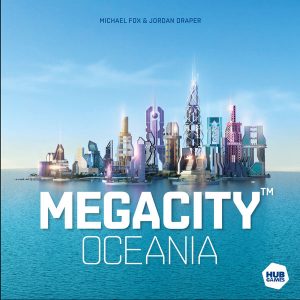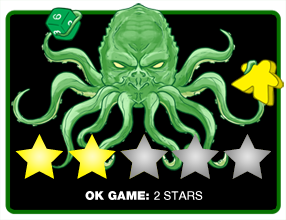 Last year we took a look at Tokyo Jutaku, one of the games in the Tokyo-inspired line from Jordan Draper. While I enjoyed the racing element of Jutaku as players tried to complete their structures in real time, that certainly didn’t appeal to everyone. Today we are looking at MegaCity: Oceania, a game which Jordan shares the designer credits on and is an evolution of his architecture-stacking game.
Last year we took a look at Tokyo Jutaku, one of the games in the Tokyo-inspired line from Jordan Draper. While I enjoyed the racing element of Jutaku as players tried to complete their structures in real time, that certainly didn’t appeal to everyone. Today we are looking at MegaCity: Oceania, a game which Jordan shares the designer credits on and is an evolution of his architecture-stacking game.
So let’s dig into how it plays and whether it belongs in the collection of stacking and dexterity fans everywhere.
Gameplay Overview:
In MegaCity: Oceania, players will be trying to complete structures and add them to the communal MegaCity. Unlike the racing nature of Jutaku, here you’ll take turns around the table choosing one of many possible actions to gather platforms, contracts, and building pieces that you can use to build up the city and score the most points.

The building pieces come in three different colors, representing different materials and a variety of awkward shapes. You’ll have contracts that will require you build on particular colored platforms, and will also indicate the minimum height and the number of pieces you must use in your construction. There may also be restrictions on what type of material or additional requirements to have archways in your building.
The actual building of the structure you’ll do between your turns. If you have a contract you have completed on your turn, you can attempt to move it into MegaCity, sliding it across the table and situating it next to the previously placed structures. If it falls during this movement, your turn ends and you start building again. Once successfully delivered, you’ll be able to move onto a new contract and you may score additional points if it’s the tallest building or next to a park.
The game ends when all of the standard contracts have been completed. There are extra difficult landmark contracts that become available when the last standard contract is taken by a player, but you’ll have very little time to complete those, but can score a bunch of points if you do. End game points are awarded for the most contracts of each color, as well as for diversifying into all the contract colors. Players total all their points and whoever has the most prestige wins!

Game Experience:
Walking past a table where MegaCity: Oceania is setup is a thing of wonder. It looks incredible on the table and the communal city that gets built in the middle of the table can be very fun to create. Unfortunately, as a game, it doesn’t really come together very well.

On most of your turns, you will find yourself picking from a bunch of not very exciting options. Usually: claim a contract, claim a platform, or take building pieces from the bag. But, if you have the platform and contract you need you’ll just take building pieces until you have the right number to complete the contract. And then rinse and repeat. The fun of the game is the building. But unlike Jutaku where that is the star of the show, MegaCity gets a bit convoluted by adding too many rules to the experience.
On top of that, those rules aren’t really all that fun to play by. Or, at the very least, will be pretty dependent on your group. What if you have everything you need but you haven’t finished building the structure when your turn starts? Do you have infinite time to construct and everyone should just wait on you? The rulebook suggests we shouldn’t rush the other players but there has to be a limit somewhere… right?

All that said, I would still be willing to give MegaCity: Oceania a somewhat average score. Finicky rules aren’t the worst thing in the world, after all. But the real let down is how easy all of the standard contract cards seem to be to complete. Needing a structure using 6 building pieces that’s height is 40 or higher wasn’t hard to accomplish. The stress really only comes in moving the structures from in front of you to the middle of the table. I would have much-preferred contracts that required more careful construction.
Final Thoughts:
MegaCity: Oceania is beautiful to look at and really fun to knock everything down at the end of the game by throwing some cards Gambit-like into the MegaCity. Unfortunately, everything else in MegaCity: Oceania was a bit of a let down for me. The requirements for the buildings are exceedingly easy and the decision-making turn to turn isn’t particularly interesting. It serves better as a playset than a game.
Final Score: 2 Stars – If you are looking for a unique stacking game, Tokyo Jutaku is just a better place to go.
Misses:
• Actions on your turn are pretty boring.
• Rules are a little loose and make for a very casual experience.
• Stacking isn’t very difficult, the only stress is moving your buildings to the middle of the table.
























